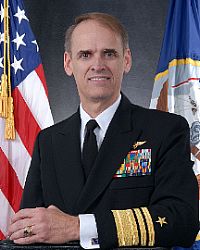
Forrest Percival Sherman was an admiral in the United States Navy and the youngest person to serve as Chief of Naval Operations until Admiral Elmo Zumwalt in 1970. The Forrest Sherman-class destroyer and the airfield at Naval Air Station Pensacola were named for him.

Michael Harold "Mike" Miller is a former Vice Admiral in the United States Navy, and was the first active-duty officer to direct the White House Military Office. He was the 61st Superintendent of the United States Naval Academy.

Admiral Thomas Bibb Hayward was Chief of Naval Operations for the United States Navy from July 1, 1978, until June 30, 1982, after which he retired from military service.

John B. Nathman is a retired United States Navy admiral who served as the Commander, United States Fleet Forces Command until 17 May 2007.

Admiral James Oren Ellis Jr. is a retired 4-star admiral and former Commander, United States Strategic Command, Offutt Air Force Base, Nebraska. He was President and Chief Executive Officer, Institute of Nuclear Power Operations until May 2012. He joined the board of directors of Lockheed Martin in 2004, and served until 2024.

Rear Admiral Richard Joseph Naughton was the superintendent of the U.S. Naval Academy from 2002 to 2003.

Ralph Andrew Ofstie was a Vice Admiral in the United States Navy, an escort carrier commander in World War II, Deputy Chief of Naval Operations (Air), and Commander of the U.S. Sixth Fleet. He was born in Eau Claire, Wisconsin and his hometown was Everett, Washington.

Gerald Roger Beaman is a retired Vice Admiral in the United States Navy and an ex Special Agent with the Federal Bureau of Investigation.

Thomas Henry Copeman III is a retired officer of the United States Navy. In mid-2009 he was appointed commandant of the Guantanamo Bay detention camps, in Cuba. His final assignment was as Commander, Naval Surface Forces Pacific from July 2012 to August 2014.

Thomas John Kilcline Jr. is a retired vice admiral of the United States Navy who served as Commander, Naval Air Forces from June 22, 2007, to July 1, 2010.

Frederick T. Moore Jr. was a United States Navy captain. During World War II, he was executive officer of Fighter Squadron 1 operating off the carrier USS Yorktown (CV-10) and commanding officer of the Air Group 35 aboard the aircraft carrier USS Chenango in the Pacific. During the Korean War, he was the commanding officer of naval air training at NAS Pensacola and the air officer on USS Coral Sea. His first sea command was aboard USS Suribachi. In 1962–1963, Moore was the eighth commanding officer of USS Saratoga. Late in his career during the Vietnam War, he was Chief of Staff of the Naval Air Training Command at Naval Air Station Pensacola from October 1965 to July 1969.

Rear Admiral Jesse Alphonzo Wilson Jr. is a retired United States Navy officer. His last active duty assignment was as commander of Naval Surface Force Atlantic.

Donald Cooke Davis was a Naval Aviator and later an admiral in the United States Navy. He was Commander of the U.S. Pacific Fleet from 1978 to 1981.

Herbert Douglas Riley was a highly decorated officer in the United States Navy with the rank of Vice admiral. A United States Naval Academy graduate, he trained as naval aviator and distinguished himself first as commanding officer of the escort carrier USS Makassar Strait during the combats at Iwo Jima and Okinawa during World War II.

Vice Admiral John Jay Donnelly is a retired American submarine officer. A graduate from the U.S. Naval Academy class of 1975, he retired in 2010 after 35 years of service.

Joseph P. Aucoin is a retired officer of the United States Navy and former commander of the United States Seventh Fleet.

William Rhode Merz is a retired United States Navy vice admiral who last served as deputy chief of naval operations for operations, plans and strategy from August 6, 2021 to October 7, 2022. He previously served as commander of U. S. Seventh Fleet from 2019 to 2021.

Randy B. Crites is a retired vice admiral of the United States Navy. He last served as Deputy Chief of Naval Operations for Integration of Capabilities and Resources from May 15, 2020, to 2023. He previously served as the Deputy Assistant Secretary of the Navy for Budget, and as director of the Fiscal Management Division in Washington, D.C., until he was promoted to the rank of vice admiral in 2020. Prior he served as the Director of OPNAV N81 Assessments Division, as Director of the Maritime Headquarters at United States Pacific Fleet, as Commander Submarine Group 10, and as Commanding officer of USS West Virginia (SSBN-736) and USS Florida (SSGN-728).

Kenneth Ray Whitesell is a retired vice admiral in the United States Navy, and the past Commander, Naval Air Forces. He retired on September 7, 2023.

Michael A. Brookes is a United States Navy rear admiral who serves as the director of the National Maritime Intelligence-Integration Office and commander of the Office of Naval Intelligence. He previously served as the director of intelligence of the U.S. Southern Command and U.S. Strategic Command.
























